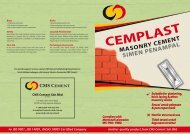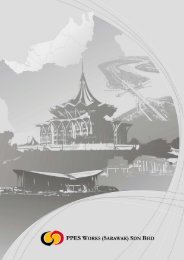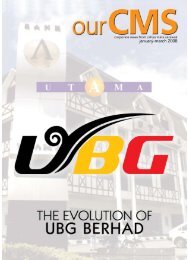Notes to the Financial Statements - Cahaya Mata Sarawak Bhd
Notes to the Financial Statements - Cahaya Mata Sarawak Bhd
Notes to the Financial Statements - Cahaya Mata Sarawak Bhd
You also want an ePaper? Increase the reach of your titles
YUMPU automatically turns print PDFs into web optimized ePapers that Google loves.
92<br />
<strong>Notes</strong> <strong>to</strong> <strong>the</strong> <strong>Financial</strong> <strong>Statements</strong><br />
For <strong>the</strong> fi nancial year ended 31 December 2011<br />
2. Summary of signifi cant accounting policies (contd.)<br />
2.15 Impairment of non-fi nancial assets (contd.)<br />
Impairment losses are recognised in profi t or loss except for assets that are previously revalued where <strong>the</strong><br />
revaluation was taken <strong>to</strong> o<strong>the</strong>r comprehensive income. In this case <strong>the</strong> impairment is also recognised in<br />
o<strong>the</strong>r comprehensive income up <strong>to</strong> <strong>the</strong> amount of any previous revaluation.<br />
An assessment is made at each reporting date as <strong>to</strong> whe<strong>the</strong>r <strong>the</strong>re is any indication that previously recognised<br />
impairment losses may no longer exist or may have decreased. A previously recognised impairment loss<br />
is reversed only if <strong>the</strong>re has been a change in <strong>the</strong> estimates used <strong>to</strong> determine <strong>the</strong> asset’s recoverable<br />
amount since <strong>the</strong> last impairment loss was recognised. If that is <strong>the</strong> case, <strong>the</strong> carrying amount of <strong>the</strong> asset<br />
is increased <strong>to</strong> its recoverable amount. That increase cannot exceed <strong>the</strong> carrying amount that would have<br />
been determined, net of depreciation, had no impairment loss been recognised previously. Such reversal<br />
is recognised in profi t or loss unless <strong>the</strong> asset is measured at revalued amount, in which case <strong>the</strong> reversal<br />
is treated as a revaluation increase. Impairment loss on goodwill is not reversed in a subsequent period.<br />
2.16 Inven<strong>to</strong>ries<br />
Inven<strong>to</strong>ries are stated at lower of cost and net realisable value. Cost incurred in bringing <strong>the</strong> inven<strong>to</strong>ries <strong>to</strong><br />
<strong>the</strong>ir present location and condition are accounted for as follows:<br />
- Raw materials and consumables: costs of purchases on a fi rst-in fi rst-out method or weighted<br />
average cost formula.<br />
- Finished goods and work-in-progress: costs of raw materials, direct labour, o<strong>the</strong>r direct costs and<br />
appropriate proportions of manufacturing overheads based on normal operating capacity.<br />
- Unsold properties: cost associated with <strong>the</strong> acquisition of land, direct costs and appropriate<br />
proportions of common costs.<br />
Net realisable value is <strong>the</strong> estimated selling price in <strong>the</strong> ordinary course of business less estimated costs<br />
of completion and <strong>the</strong> estimated costs necessary <strong>to</strong> make <strong>the</strong> sale.<br />
2.17 Construction and service contracts<br />
Where <strong>the</strong> outcome of a construction or service contract can be reliably estimated, contract revenue and<br />
contract costs are recognised as revenue and expenses respectively by using <strong>the</strong> stage of completion<br />
method. The stage of completion is measured by reference <strong>to</strong> ei<strong>the</strong>r <strong>the</strong> proportion of costs incurred <strong>to</strong>date<br />
<strong>to</strong> <strong>the</strong> <strong>to</strong>tal estimated costs or <strong>the</strong> completion of a physical proportion of contract work <strong>to</strong>-date.<br />
Where <strong>the</strong> outcome of a construction or service contract cannot be reliably estimated, contract revenue<br />
is recognised <strong>to</strong> <strong>the</strong> extent of contract costs incurred that are likely <strong>to</strong> be recoverable. Contract costs are<br />
recognised as expenses in <strong>the</strong> period in which <strong>the</strong>y are incurred.<br />
When it is probable that <strong>to</strong>tal contract costs will exceed <strong>to</strong>tal contract revenue, <strong>the</strong> expected loss is<br />
recognised as an expense immediately.<br />
Contract revenue comprises <strong>the</strong> initial amount of revenue agreed in <strong>the</strong> contract and variations in contract<br />
work, claims and incentive payments <strong>to</strong> <strong>the</strong> extent that it is probable that <strong>the</strong>y will result in revenue and <strong>the</strong>y<br />
are capable of being reliably measured.<br />
When <strong>the</strong> <strong>to</strong>tal of costs incurred on construction or service contracts plus recognised profi ts (less<br />
recognised losses) exceed progress billings, <strong>the</strong> balance is classifi ed as amount due from cus<strong>to</strong>mers on<br />
contracts. When progress billings exceed costs incurred plus, recognised profi ts (less recognised losses),<br />
<strong>the</strong> balance is classifi ed as amount due <strong>to</strong> cus<strong>to</strong>mers on contracts.<br />
Cahya <strong>Mata</strong> <strong>Sarawak</strong> Berhad







